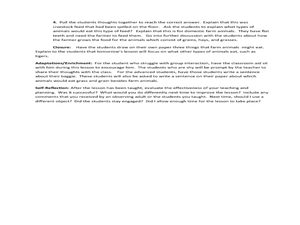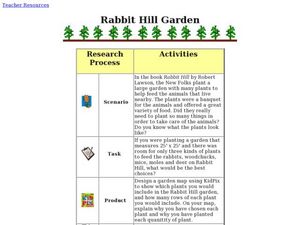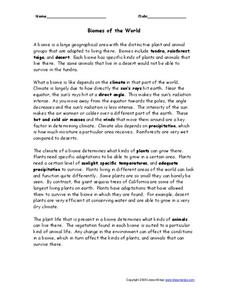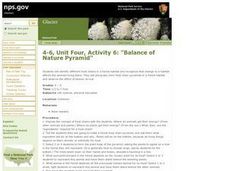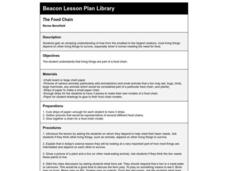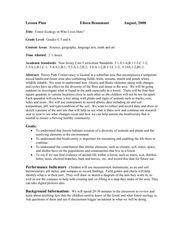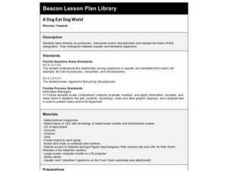Curated OER
Seed Sorting 101
Students sort through numerous seeds to find similarities and differences. In this sorting and classifying lesson, students divide up different plant seeds based on their similarities and differences, while keeping record of their findings.
Curated OER
A Rainbow Under the Sea: How Do Animals Survive in the Ocean?
Second graders, with adult help, create a PowerPoint presentation on a selected ocean animal.
Curated OER
Animal Life Histories Derived From Morphology
Students learn the mechanisms of natural selection by deducing information from the physical appearance of the animal.
Curated OER
Why Do We Need Petroleum?
Students learn the many ways petroleum is used in our industrial society, and the advantages and disadvantages of its use. They explore what it would be like to live in a world without petroleum.
Curated OER
What's in it and Who Eats it?
First graders explore farming by illustrating images. In this livestock activity, 1st graders discuss what types of plants are used to feed livestock animals and how pets and humans eat the livestock animals. Students draw images of what...
Curated OER
Arctic Food Web
Students research animals found in the arctic. They discuss what living things need in order to survive and where they get their food. Students discuss the difference between producers and consumers and create a food web for animals in...
Curated OER
Rabbit Hill Garden
Students read the story Rabbit Hill and research how to design their own garden. In this reading and gardening lesson plan, students design their garden on KidPix and then choose plants for their garden.
Curated OER
Biomes of the World
In this biomes worksheet, students read an article on biomes and answer 10 multiple choice, short answer or true and false questions relating to biomes.
Curated OER
Balance of Nature Pyramid
Students study the concept of food chains and create a physical forest food chain pyramid. In this balance of nature pyramid instructional activity, students identify the ingredients needed on each level of the pyramid then make...
Curated OER
The Food Chain
First graders explore how most living things, big and small, need food for survival.
Curated OER
Animal Games
Students explore a variety of games on the Internet that will teach them about animals; they focus on the Florida panther. Students choose the activity that is of interest to them, and then rotate between the games online and the games...
Curated OER
Forest Ecology or Who Lives Here?
Pupils explore a hardwood forest. In this forest ecology lesson, students examine the diversity and animals and plants as they explore their habitats at Poricy Park Conservatory. Pupils determine how biodiversity and abiotic elements...
Curated OER
Building You From Moo
Learners are given an envelope that turns each of them into either a field of grass, or a diary cow, or a famous person (only one type of organism per student). The object is to get the correct building blocks for proteins (amino acids)...
Curated OER
Prairies
students make booklets about each of the following: reptiles, birds, plants, animals and buffalo. Each was information and contained the facts covered in class. they research one specific area in which they were especially interested....
Curated OER
Create a Food Chain
Students explore the food chain and the ways that animals depend on each other and on plants for food. They create a paper chain with different colors relating to carnivores and herbivores. The chains are linked to the sun to create a...
Curated OER
Marine & Aquatic Habitats Activities - Walk in the Wetlands
Students research various types of fresh water wetlands and identify the common animal and plant life in these different ecosystems. They further analyze the need to protect these wetlands and explore their varied uses.
Curated OER
HAPPY SOIL, SAD SOIL
Students will be able to identify the characteristics of healthy soil and unhealthy soil.Take the class outside to an area of thick grass near trees, if available. Compare the
clothes people wear to the thin cover. Discuss the reasons...
Curated OER
Building a Butterfly Garden
Students plant a garden which will become the habitat for butterflies as they go through their life cycle. In this life cycle lesson, students grow plants that attract butterflies and feed caterpillars in order to observe the entire...
Curated OER
Cells are 3-D!
Students design three dimensional models of plant and animal cells. They identify the cells parts, and compare animal and plant cells.
Curated OER
Home Sweet Home
Students examine the animals that live in trees. They identify their sounds, footprints and droppings. They draw pictures of the animals as well.
Curated OER
White-tailed Deer Issues
Ninth graders examine the white tail deer population in Pennsylvania and explore the impacts that the deer have on the flora and fauna. For this white-tail deer lesson students complete an activity and graph their results.
Curated OER
Dinosaurs 2: What Were Dinosaurs Like?
Students compare and contrast dinosaurs to animals that are alive today through basic research.
Curated OER
A Dog Eat Dog World
Fourth graders distinguish between acquatic and terrestrial organisms. They label animals as producers, consumers, and/or decomposers.
Curated OER
Understanding Climate
Fourth graders create two dioramas out of household materials to compare the influence of various factors that impact climate. Each group discuss how the change in factors influenced the climate, flora, and fauna of their area.






